All about cultivator cutters

Cutters are a key component of a motor cultivator and can significantly simplify the gardener's work and speed up the work process. Depending on the variety, they are able to cope with different functions. However, they cannot be called universal, which depends on the complexity of the treated soil and the type of this or that device. In the article you will read about the varieties of cultivator knives and their features, find out if they need sharpening and which one is better for different soil.

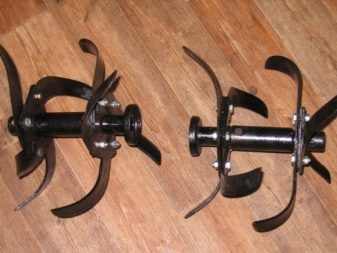
Appointment
Today, gardeners have learned to perform various types of work with the help of cutters. For example, knives are used to destroy dense thickets of weeds, cultivate soil, and mix layers of soil with fertilizers. In addition, the use of cultivator cutters is important when you need to level the soil surface. At the same time, the varieties are able to effectively manifest themselves when plowing virgin lands in pastures and meadows.
They affect the quality of plowing, ease of control of the cultivator in the process of cultivating the land.and also affect the reliability of the transmission of the device. In addition, they affect the functioning of the working unit of the cultivator.
Depending on the variety, they can reduce the number of weeds and saturate the soil with oxygen. At the same time, cutters differ in the number of cutting edges, their location and design.
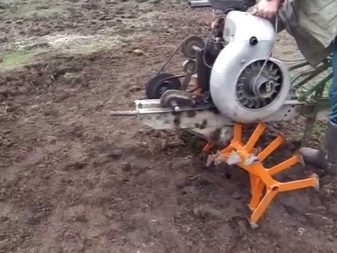
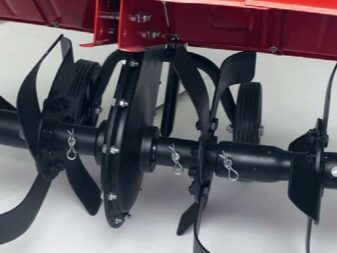
Varieties
Today, two types of cutters are known: according to their location, they are side and mounted. If we classify them according to their shape, we can distinguish saber varieties and the "crow's feet" variant. As for the saber-type product, these are the most common cultivation attachments, which are often equipped with most motor-cultivators. Depending on the manufacturer, the products can be supplied disassembled or assembled.
These options represent an axis to which plates are welded with knives in the form of sabers fixed on them. The sections are identical and are bolted together. The more the section has attachments, the wider the coverage of the soil and, therefore, the width of cultivation. These cutters work well on previously tilled land.

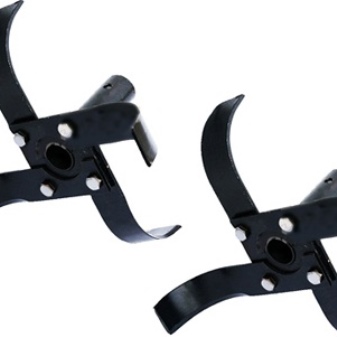
As for the “crow's feet” modification, these cutters, unlike the previous version, are non-separable. Therefore, they cannot be repaired in the event of a breakdown of one element. Here you will have to completely change attachments. As for the number of sections, it is chosen individually, adjusting to their own interests. It is these nozzles that work with difficult soil.
Bushings for such models are round or hexagonal. These modifications cope with the interruption of plants in the process of cultivating the soil. They are characterized by a reduced load on the gearbox.
Products of this type provide for work with motor vehicles in which there is an air cooling system. In addition, these cutters are easy to operate in the process.

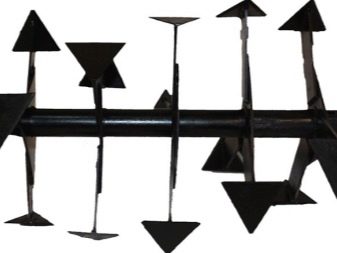
Another type of knives for a motor-cultivator are the so-called "virgin land" options. These cutters are quite powerful and reliable. It is customary for them to work the soil at greater depths. When considering the best of the three types of knives, the type of soil is worth considering.
For light soil, a factory saber product is sufficient. To reduce the load on the cultivator, it is worth purchasing "crow's feet". If you really need to cultivate difficult soil, you should take a closer look at the "virgin land" option.
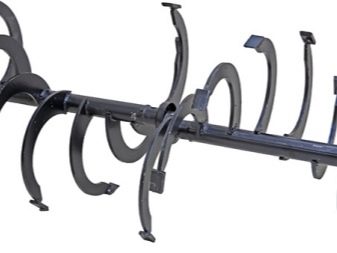
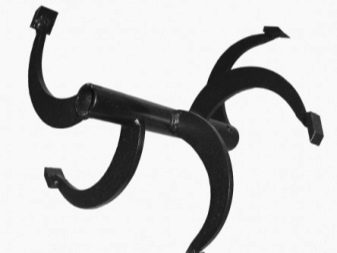
Do I need to sharpen?
There is no unequivocal answer to the question of whether it is necessary to sharpen a knife. Gardeners have their own opinion, but it is also contradictory. According to them, the need for sharpening may depend on the type of soil being cultivated. For example, if the soil is sandy or peaty, you do not need to sharpen the cultivator's knife. If they cultivate virgin soil, more than once you can hear about the need to sharpen the blades. As for the opinion of manufacturers, it clearly indicates that sharpening is not necessary for cutters.
Often, gardeners note that the knives do not become blunt during operation. Manufacturers, however, point out that it is more important to remove weeds from the blades, since it is from this that the quality of soil cultivation deteriorates.
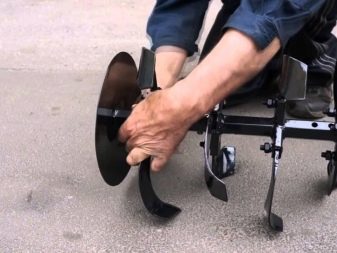
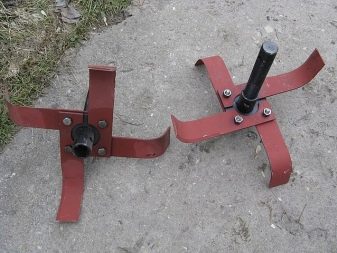
Experts note that the sharpening of the cutters is accompanied by the crushing of weeds. This contributes to their enhanced vegetative reproduction, and also requires disassembly of knives.
Of course, the unit will work more efficiently for two or three hours, but then the blades will need to be disassembled and sharpened again. And this will require compliance with the assembly rules, because after sharpening, you will have to correctly assemble the working unit, and this can not be done by every gardener. As for a heavy cultivator with rather powerful cutters, there is no need for sharpening. In addition to the fact that it will take a lot of time and effort, the user will hardly feel the effect.
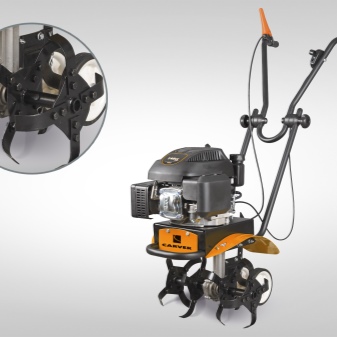
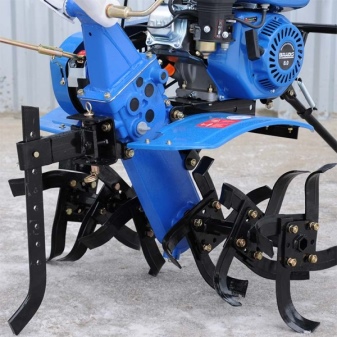
Choice for a rotary cultivator
When choosing a cutter for a cultivator, one should take into account how the knives mounted on the shaft were assembled. For example, models can be bent in one, different directions. Versions with a direction in one direction are convenient in that in this way it is possible to prevent damage to plants during the loosening process. However, such modifications have a smaller coverage of the cultivated soil.
For cultivation of fallow lands covered with dense vegetation, reliable cutters are needed. The working bodies of such cutters are lamellar knives fixed on rotating shafts.
Here it is necessary to purchase products that can effectively crush the soil with a small depression in the ground.
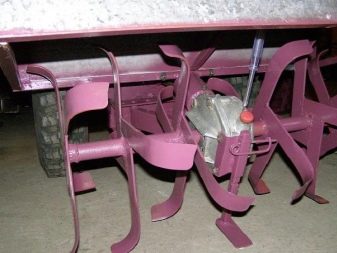

The four-rotor vertical milling cutters with hydraulic sideshift and sideshift are good for tilling near-trunk strips in low-row spacing conditions. In addition to being relevant for weed removal with shallow working depths, they are good for inter-row cultivation without creating furrows in the lateral movement.
To choose the right option, you need to consider the type of cultivator itself. In addition, you need to choose a product taking into account the upcoming work and technical characteristics. However, in any case, the immersion in the ground of the device should be smooth. It is also important to do this slowly, as rushing can cause the knives to break.

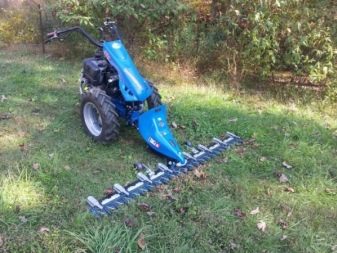
Installation
If the user has purchased the cutters without assembly, they must be properly assembled. Today this is not difficult, since the buyer has at his disposal not only detailed instructions from the manufacturer, but also a wide range of video material that can be obtained on the Internet. When assembling the product, it is important to ensure that the active part of the machine enters the soil during operation. Side options are installed on both sides of the walk-behind tractor, they work from drive shafts and wheels. In this position, the cutters are a practical replacement for the wheels of a motor-cultivator, it is they who set motor vehicles in motion.
The power take-off cutters are located behind the cultivator. They do not take part in the movement of the device.
To install any option on a cultivator, it is advisable to use the help of a partner. This will avoid injury, falls, and damage to equipment. At the very beginning, you need to raise the walk-behind tractor.
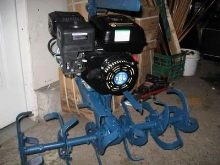
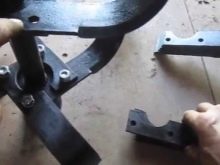
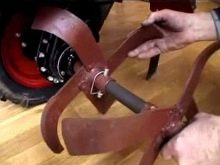
To install the cutters on the cultivator, it is necessary to use special wooden trestles with a height of about 50 cm. Also, in this case, the equipment must not only be raised, but also rest on the opener, and also tilted at an angle of 45 degrees. Then the wheels are removed from the cultivator and cutters are placed in this place. Further, special plates should be installed on the outer ends on both sides, due to which the movement of the device will be smooth and stable.
Additional sections are installed to the main ones by using pins. The restraining metal disc is connected to the frame by means of bolts. In this case, the number of blades should be selected for the cultivator, based on its power. To assemble the cutting blades, it is permissible to use one or more axes. When assembling a four-petal cutter, it is important to consider the sequence of the right and left blades that are placed on the mounting plate.
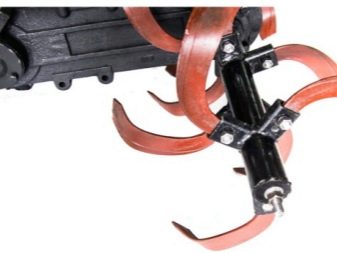
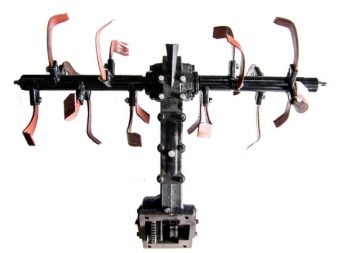
Comparison
The crow's feet attachment is suitable for dense ground. It can be used on different modifications of motor cultivators due to the variability of the sleeve. These models are easier to control during operation, but they are afraid of jerks and shocks during soil processing. Active analogs or factory-type products do not always cope with heavy soil. This is especially true for options with Chinese knives, where the quality of the metal leaves much to be desired. Not only will it be difficult for the user to hold the equipment in his hands, but, in addition, the load on the gearbox will significantly increase.
These cutters can be repaired by removing damaged parts and replacing them with new ones. In addition, there is a width lock here. At the request of the operator, additional pairs of cutters can be placed in a row.
If it is known in advance that the processing of difficult soil is needed, here you will either have to select high-quality cutters from manufacturers from Ukraine and Poland, or look for other modifications.
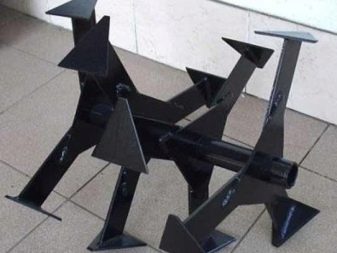
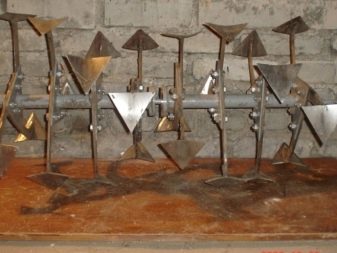
As for the spiral cutters, called "virgin soil", then this design is all-welded, which is done precisely to increase its strength characteristics during operation. That is why it can withstand heavy loads. The only thing that the user may not like is the slowness of the work. However, it is understandable: it will not be possible to accelerate on virgin soil, no matter how we would like it.
If you want to buy just such a version of cutters, it is important to take into account one more of its drawbacks. - during cultivation, the earth will be pushed out from the center to the edges. This will form a shallow furrow, which may further require leveling the land plot. For the rest, spiral cutters are considered more reliable devices in comparison with other counterparts. They are strong, reliable and durable. If you need high-quality soil cultivation in a difficult area, they will be the optimal help for the gardener.
A comparison of cutters awaits you in the next video.



































































The comment was sent successfully.